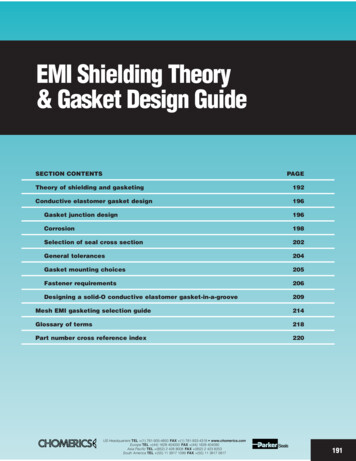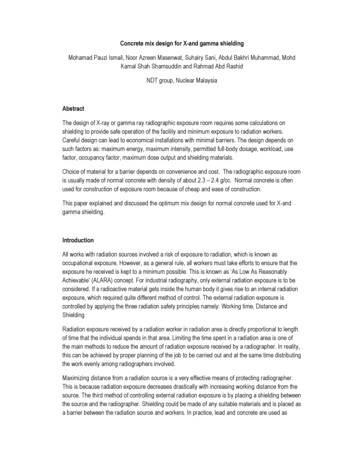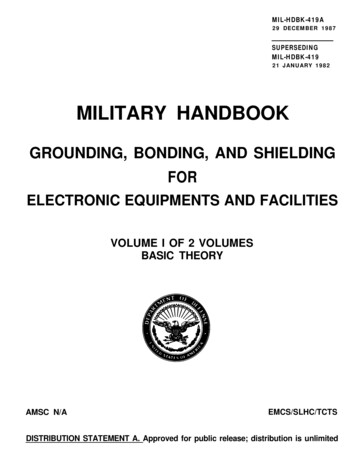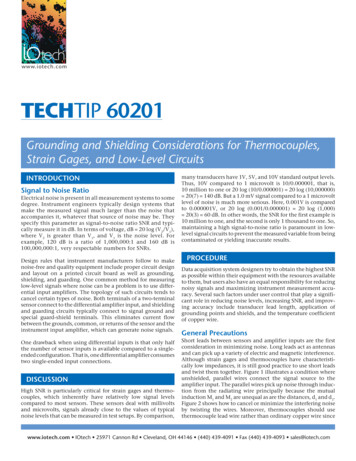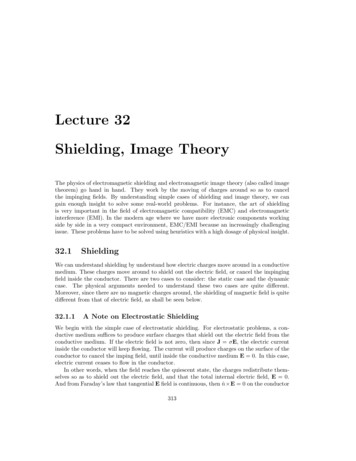
Transcription
Lecture 32Shielding, Image TheoryThe physics of electromagnetic shielding and electromagnetic image theory (also called imagetheorem) go hand in hand. They work by the moving of charges around so as to cancelthe impinging fields. By understanding simple cases of shielding and image theory, we cangain enough insight to solve some real-world problems. For instance, the art of shieldingis very important in the field of electromagnetic compatibility (EMC) and electromagneticinterference (EMI). In the modern age where we have more electronic components workingside by side in a very compact environment, EMC/EMI because an increasingly challengingissue. These problems have to be solved using heuristics with a high dosage of physical insight.32.1ShieldingWe can understand shielding by understand how electric charges move around in a conductivemedium. These charges move around to shield out the electric field, or cancel the impingingfield inside the conductor. There are two cases to consider: the static case and the dynamiccase. The physical arguments needed to understand these two cases are quite different.Moreover, since there are no magnetic charges around, the shielding of magnetic field is quitedifferent from that of electric field, as shall be seen below.32.1.1A Note on Electrostatic ShieldingWe begin with the simple case of electrostatic shielding. For electrostatic problems, a conductive medium suffices to produce surface charges that shield out the electric field from theconductive medium. If the electric field is not zero, then since J σE, the electric currentinside the conductor will keep flowing. The current will produce charges on the surface of theconductor to cancel the imping field, until inside the conductive medium E 0. In this case,electric current ceases to flow in the conductor.In other words, when the field reaches the quiescent state, the charges redistribute themselves so as to shield out the electric field, and that the total internal electric field, E 0.And from Faraday’s law that tangential E field is continuous, then n̂ E 0 on the conductor313
314Electromagnetic Field Theorysurface since n̂ E 0 inside the conductor. Figure 32.1 shows the static electric field, in thequiescent state, between two conductors (even though they are not PEC), and the electricfield has to be normal to the conductor surfaces.32.1.2Relaxation TimeThe time it takes for the charges to move around until they reach their quiescent distributionsuch that E(t) 0 is called the relaxation time. It is very much similar to the RC timeconstant of an RC circuit consisting of a resistor in series with a capacitor. It can be proventhat this relaxation time is related to ε/σ, but the proof is beyond the scope of this courseand it is worthwhile to note that this constant has the same unit as the RC time constant.Note that when σ , the relaxation time is zero. In other words, in a perfect conductoror a superconductor, the charges reorient themselves instantaneously if the external field istime-varying so that E(t) 0 always.Electrostatic shielding or low-frequency shielding is important at low frequencies. TheFaraday cage or Faraday shield is an important application of such a shielding [175].Figure 32.1: The objects can just be conductors, and in the quiescent state (static state), thetangential electric field will be zero on their surfaces.However, if the conductor charges are induced by an external electric field that is timevarying, then the charges have to constantly redistribute/re-orient themselves to try to shieldout the incident time-varying electric field. Currents have to constantly flow around theconductor. Then the electric field cannot be zero inside the conductors as shown in Figure32.2. In other words, a finite conductor cannot shield out completely a time-varying electricfield.For a perfect electric conductor (PEC), E 0 inside with the following argument: BecauseJ σE where σ , let us assume an infinitesimally small time-varying electric field in thePEC to begin with. It will yield an infinitely large electric current, and hence an infinitelylarge time-varying magnetic field. An infinite time-varying magnetic field in turn yields aninfinite electric field that will drive an electric current, and these fields and current will beinfinitely large. This is an unstable sequence of events if it is true. Moreover, it will generate
Shielding, Image Theory315Figure 32.2: If the source that induces the charges on the conductor is time varying, thecurrent in the conductor is always nonzero so that the charges can move around to respondto the external time-varying charges. The two figures above show the orientation of thecharges for two snap-shot in time.infinite energy in the system, which is not physical. Hence, the only possibility is for thetime-varying electromagnetic fields to be zero inside a PEC.Thus, for the PEC, the charges can re-orient themselves instantaneously on the surfacewhen the inducing electric fields from outside are time varying. In other words, the relaxationtime ε/σ is zero. As a consequence, the time-varying electric field E is always zero insidePEC, and therefore, n̂ E 0 on the surface of the PEC, even for time-varying fields.32.2Image TheoryThe image theory here in electromagnetics is quite different from that in optics. As mentionedbefore, when the frequency of the fields is high, the waves associated with the fields can bedescribed by rays. Therefore ray optics can be used to solve many high-frequency problems.We can use ray optics to understand how an image is generated in a mirror. But the imagetheory in electromagnetics is quite different from that in optics.Image theory can be used to derived closed form solutions to boundary value problemswhen the geometry is simple and has a lot of symmetry. These closed form solutions in turnoffer physical insight into the problems. This theory or method is also discussed in manytextbooks [1, 38, 49, 60, 72, 167, 176].32.2.1Electric Charges and Electric DipolesImage theory for a flat conductor surface or a half-space is quite easy to derive. To see that,we can start with electro-static theory of putting a positive charge above a flat plane. Asmentioned before, for electrostatics, the plane or half-space does not have to be a perfectconductor, but only a conductor (or a metal). The tangential static electric field on thesurface of the conductor has to be zero.The tangential static electric field can be canceled by putting an image charge of oppositesign at the mirror location of the original charge. This is shown in Figure 32.3. Now we canmentally add the total field due to these two charges. When the total static electric field dueto the original charge and image charge is sketched, it will look like that in Figure 32.4. It
316Electromagnetic Field TheoryFigure 32.3: The use of image theory to solve the BVP of a point charge on top of a conductor.The boundary condition is that n̂ E 0 on the conductor surface.is seen that the static electric field satisfies the boundary condition that n̂ E 0 at theconductor interface due to symmetry.An electric dipole is made from a positive charge placed in close proximity to a negativecharge. Using that an electric charge reflects to an electric charge of opposite polarity abovea conductor, one can easily see that a static horizontal electric dipole reflects to a statichorizontal electric dipole of opposite polarity. By the same token, a static vertical electricdipole reflects to static vertical electric dipole of the same polarity as shown in Figure 32.5.If this electric dipole is a Hertzian dipole whose field is time-varying, then one needs aPEC half-space to shield out the electric field. Also, the image charges will follow the originaldipole charges instantaneously. Then the image theory for static electric dipoles over a halfspace still holds true if the dipoles now become Hertzian dipoles, but the surface will have tobe a PEC surface so that the fields can be shielded out instantaneously.32.2.2Magnetic Charges and Magnetic DipolesA static magnetic field can penetrate a conductive medium. This is apparent from ourexperience when we play with a bar magnet over a copper sheet: the magnetic field from themagnet can still be experienced by iron filings put on the other side of the copper sheet.However, this is not the case for a time-varying magnetic field. Inside a conductivemedium, a time-varying magnetic field will produce a time-varying electric field, which inturn produces the conduction current via J σE. This is termed eddy current, which byLenz’s law, repels the magnetic field from the conductive medium.11 The repulsive force occurs by virtue of energy conservation. Since “work done” is needed to set the eddycurrent in motion in the conductor, or to impart kinetic energy to the electrons forming the eddy current,a repulsive force is felt in Lenz’s law so that work is done in pushing the magnetic field into the conductivemedium.
Shielding, Image Theory317Figure 32.4: The total electric of the original problem and the equivalent problem when weadd the total electric field due to the original charge and the image charge.Now, consider a static magnetic field penetrating into a perfect electric conductor, anminute amount of time variation will produce an electric field, which in turn produces aninfinitely large eddy current. So the stable state for a static magnetic field inside a PEC isfor it to be expelled from the perfect electric conductor. This in fact is what we observe whena magnetic field is brought near a superconductor. Therefore, for the static magnetic field,where B 0 inside the PEC, then n̂ · B 0 on the PEC surface.Now, assuming a magnetic monopole exists, it will reflect to itself on a PEC surface sothat n̂ · B 0 as shown in Figure 32.6. Therefore, a magnetic charge reflects to a charge ofsimilar polarity on the PEC surface.By extrapolating this to magnetic dipoles, they will reflect themselves to the magneticdipoles as shown in Figure 32.7. A horizontal magnetic dipole reflects to a horizontal magneticdipole of the same polarity, and a vertical magnetic dipole reflects to a vertical magnetic dipoleof opposite polarity. Hence, a dipolar bar magnet can be levitated by a superconductor whenthis magnet is placed closed to it. This is also known as the Meissner effect [177], which isshown in Figure 32.8.A time-varying magnetic dipole can be made from a electric current loop. Over a PEC, atime-varying magnetic dipole will reflect the same way as a static magnetic dipole as shownin Figure 32.7.
318Electromagnetic Field TheoryFigure 32.5: On a conductor surface, a horizontal static dipole reflects to one of oppositepolarity, while a static vertical dipole reflects to one of the same polarity. If the dipoles aretime-varying, then a PEC will have a same reflection rule.Figure 32.6: On a PEC surface, n̂ · B 0. Hence, a magnetic monopole on top of a PECsurface will have magnetic field distributed as shown.32.2.3Perfect Magnetic Conductor (PMC) SurfacesMagnetic conductor does not come naturally in this world since there are no free-movingmagnetic charges around. Magnetic monopoles are yet to be discovered. On a PMC surface,by duality, n̂ H 0. At low frequency, it can be mimicked by a high µ material. One cansee that for magnetostatics, at the interface of a high µ material and air, the magnetic fluxis approximately normal to the surface, resembling a PMC surface.High µ materials are hard to find at higher frequencies. Since n̂ H 0 on such a surface,no electric current can flow on such a surface. Hence, a PMC can be mimicked by a surfacewhere no surface electric current can flow. This has been achieved in microwave engineeringwith a mushroom surface as shown in Figure 32.9 [179]. The mushroom structure consisting ofa wire and an end-cap, can be thought of as forming an LC tank circuit. Close to the resonancefrequency of this tank circuit, the surface of mushroom structures essentially becomes opencircuits with no or little current flowing on the surface, or Js 0. This resembles a PMC,because with no surface electric current on this surface, the tangential magnetic field is small,the hallmark of a good magnetic conductor, by the duality principle.Mathematically, a surface that is dual to the PEC surface is the perfect magnetic conductor(PMC) surface. The magnetic dipole is also dual to the electric dipole. Thus, over a PMCsurface, these electric and magnetic dipoles will reflect differently as shown in Figure 32.10.
Shielding, Image Theory319Figure 32.7: Using the rule of how magnetic monopole reflects itself on a PEC surface, thereflection rules for magnetic dipoles can be ascertained.Figure 32.8: On a PEC (superconducting) surface, a vertical magnetic dipole reflects to oneof opposite polarity. Hence, the dipoles repel each other displaying the Meissner effect. Themagnet, because of the repulsive force from its image, levitates above the superconductor(courtesy of Wikipedia [178]).One can go through Gedanken experiments and verify that the reflection rules are as shownin the figure.32.2.4Multiple ImagesFor the geometry shown in Figure 32.11, one can start with electrostatic theory, and convinceoneself that n̂ E 0 on the metal surface with the placement of charges as shown. Forconducting media, they charges will relax to the quiescent distribution after the relaxationtime. For PEC surfaces, one can extend these cases to time-varying dipoles because thecharges in the PEC medium can re-orient instantaneously (i.e. with zero relaxation time) toshield out or expel the E and H fields. Again, one can repeat the above exercise for magneticcharges, magnetic dipoles, and PMC surfaces.
320Electromagnetic Field TheoryFigure 32.9: A mushroom structure operates like an LC tank circuit. At the right frequency,the surface resembles an open-circuit surface where no current can flow. Hence, tangentialmagnetic field is zero resembling perfect magnetic conductor (courtesy of Sievenpiper [179]).32.2.5Some Special CasesOne curious case is for a static charge placed near a conductive sphere (or cylinder) as shown inFigure 32.12.2 A charge of Q reflects to a charge of QI inside the sphere. For electrostatics,the sphere (or cylinder) need only be a conductor. However, this cannot be generalized toelectrodynamics or a time-varying problem, because of the retardation effect: A time-varyingdipole or charge will be felt at different points asymmetrically on the surface of the spherefrom the original and image charges. Exact cancelation of the tangential electric field on thesurface of the sphere or cylinder cannot occur for time-varying field.When a static charge is placed over a dielectric interface, image theory can be used tofind the closed form solution. This solution can be derived using Fourier transform techniquewhich we shall learn later [34]. It can also be extended to multiple interfaces. But imagetheory cannot be used for the electrodynamic case due to the different speed of light indifferent media, giving rise to different retardation effects.2 Thisis worked out in p. 48 and p. 49, Ramo et al [30].
Shielding, Image Theory321Figure 32.10: Reflection rules for electric and magnetic dipoles over a PMC surface.Figure 32.11: Image theory for multiple images [30].Figure 32.12: Image theory for a point charge near a cylinder or a sphere can be found inclosed form [30].
322Electromagnetic Field TheoryFigure 32.13: A static charge over a dielectric interface can be found in closed form.
Shielding, Image Theory The physics of electromagnetic shielding and electromagnetic image theory (also called image theorem) go hand in hand. They work by the moving of charges around so as to cancel the impinging elds. By understanding simple cases of shielding and image theory, we c

